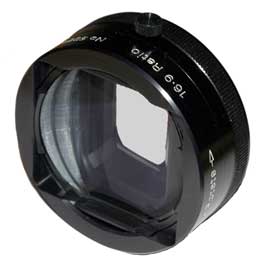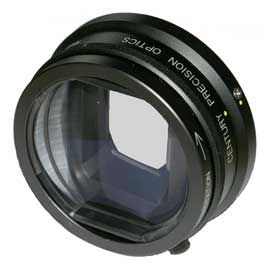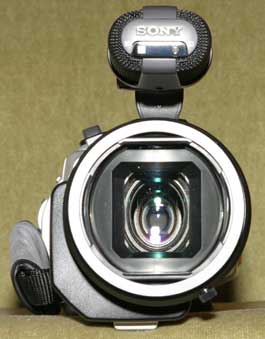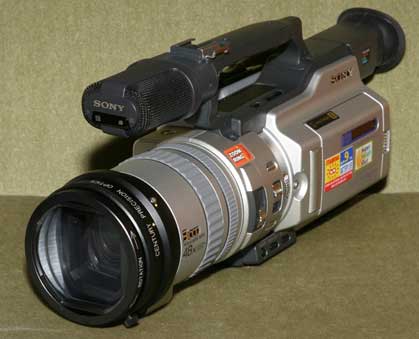

 |
 |
| Sony 16:9, f5.6, Wide Zoom. | Optex, f5.6, Matching Zoom. |
As well as better definition in normal use the adaptor also gives a wider field of view, similar to the Sony VCLHG0758 wide angle adaptor. Of course, like this and any other wide angle adaptor, the anamorphic adaptors also worsen barrel distortion at the widest zoom settings, roughly doubling that of the unadapted camera lens. They also suffer from some residual second order chromatic aberration at the extremes of field (red image slightly wider than green and blue) and a small loss of definition in the corners. All of these effects are insignificant when the field of view with the adaptor is adjusted to be similar to that of the camera lens alone at its widest setting as can be seen below in this stunning image taken at about one quarter zoom:

Christchurch Mansion, Ipswich. Click on Image for Full Screen Version (filesize 137KB).
So, having established that the anamorphic adaptors are worth using, the next question is which is best. Visual inspection of both lenses produced the conclusion that they are identical optically and use many of the same mechanical components with the only difference being in the outer housings! The Optex lens is slightly deeper front to back with what looks like a vestigial lens hood. This offers some small reduction in the risk of flare from sunlight etc. but slightly increases the chance of vignetting as discussed later. Testing confirmed their optical similarity so these are the only functional differences between the two lenses.
 |
 |
| Optex OTDV58ANA. | Century Optics DS-1609-SB. |
 |
 |
| Optex. Full Zoom at 4m and f2.4. | Optex. Full Zoom at 4m and f9.6. |
Secondly I was warned by Optex about the risk of vignetting on some of the VX2000/PD150 cameras although assured this was small and not present on other cameras with smaller lenses (e.g. 52mm rather than 58mm) such as the Sony PD100, TRV900, VX9000, DSR200, VX1000 or Canon XM1 & 2. My camera does show a totally black strip on the left hand side with this lens, due to a slight off-centre placement of the CCD sensor array, calculated at 8 pixels. In fact the Optex lens at full wide setting transmits about the 702 pixels of the analogue active line length, rather than the 720 pixels of the full digital line length. With a centred sensor this would be perfectly acceptable for all but web use as all TVs must be designed for the analogue line length so the vignetting would never be seen. It is also invisible in the viewfinder. Even for web use you would only need to crop off 2% and would still have a much wider field of view than the unadapted Sony lens. The Century lens is better in this respect on the VX2000/PD150 but neither lens should suffer from this effect on the other cameras listed. The images below show the worst case at wide-angle with full aperture and normal apertures on my VX2000 with offset sensor but the effect reduces gradually to zero as you zoom in. Only the left 72 pixels (10%) of the centerline of the images are shown as all are reasonably consistent over the whole image height and on my camera had insignificant vignetting on the right hand side. Any vignetting would of course be shared equally on both sides on cameras with a centred sensor:
 |
 |
| Optex, Wide, f1.6, Left 72 pixels. | Century, Wide, f1.6, Left 72 pixels. |
 |
 |
| Optex, Wide, f5.6, Left 72 pixels. | Century, Wide, f5.6, Left 72 pixels. |
 |
 |
| Visual Alignment Method. | Sony VX2000 with Century Optics Lens. |
It is also worth noting that the price of these lenses is partly due to the difficulty in manufacture. An anamorphic lens uses two matched cylindrical elements, one positive and the other negative. Their spacing reduces the image horizontally from 16:9 to 4:3. Unlike a normal lens where grinding or matching errors simply cause a change of focal length which can be easily corrected by refocussing, with anamorphic adaptors any mismatch causes astigmatism which cannot be corrected and results in a different focal point for horizontal and vertical edges. Design of these non zoom-through adaptors is balanced for distant scenes and normal angles of view but their correction fails at very close distances or higher zoom. Under these conditions the only solution is to stop down the camera lens to reduce the error. Thus high zoom or close-up use in poor light must be avoided - under these conditions the built in conversion should be used but otherwise the adaptor is better. So if you want a close-up in poor light "to catch the tear in the eye of the Bride's mother" don't use the adaptor!!
The choice then for the PD150 is between Century at £620 (possible discounts in this price) or Optex at £475, both plus VAT. The Optex shows some vignetting over part of the zoom range but I am assured this does not happen on all PD150s or on the other cameras listed above, presumably due to different front element sizes and different wide angle capabilities. This vignetting is invisible in the viewfinder and on normal TVs but may need some cropping if used for the web. Otherwise both behave identically. The choice is yours! Because of the off centre sensor on my camera and a slight preference for the bayonet fitting I bought the Century lens. For those who are happy to pay more it is worth noting that Century Optics have now developed a new zoom-through adaptor at a recommended price of £995+VAT though how this compares must be the subject of another review.
Gordon
Copyright GTH Electronics 1997 - 2025
Click Here to Return to the
GTH Home Page
| Email to: sales@gthelectronics.com | Telephone: 01692 402501 | International Tel: +44 1692 402501 |